Optimal Design and Analysis of a Hybrid Hydrogen Energy Storage System for an Island-Based Renewable Energy Community
Abstract
:1. Introduction
2. Contribution
- The modelling of a hybridised battery and RHFC system for a remote renewable energy community application using real-world power consumption data from a rural island location;
- the use of multi-objective optimisation to evaluate the system pareto front based on economic and environmental performance;
- the inclusion of a virtual trading layer based on the latest RED(III) REC policies;
- the formulation of a scalable and modular renewable energy community modelling and simulation platform.
3. Materials and Methods
3.1. Renewable Energy Community Implementation
3.2. Weather and Environment Data
3.3. System Design and Characteristics
3.3.1. PV Solar Array Model
3.3.2. Wind Turbine Model
3.3.3. Lithium Ion Battery Model
3.3.4. Regenerative Hydrogen Fuel Cell
3.3.5. Model Input Assumptions
3.4. Energy Management Strategy
3.5. Economic and Environmental Indicators
3.6. Multi-Objective Optimisation Procedure
4. Results and Discussion
4.1. Optimisation Results of the Hybrid Energy Generation and Storage Renewable Energy Community
4.2. Best Hybrid System Design for the Renewable Energy Community
4.2.1. Techno-Economic Assessment
4.2.2. REC Members’ Net Savings and Environmental Impacts
4.3. Best Case and Extremes Comparison
4.4. Pareto Front Comparison of Energy Storage System Technologies
5. Conclusions
Author Contributions
Funding
Data Availability Statement
Acknowledgments
Conflicts of Interest
Abbreviations
| CAPEX | Capital Expenditure |
| DOD | Depth of Discharge |
| ESS | Energy Storage System |
| GA | Genetic Algorithm |
| GHI | Global Horizontal Irradiance |
| GWP | Global Warming Potential |
| IEC | International Electrotechnical Commission |
| IRR | Internal Rate of Return |
| LCOE | Levelised Cost of Electricity |
| NPV | Net Present Value |
| NSGA | Non-dominated Sorting Genetic Algorithm |
| OPEX | Operational Expenditure |
| PEM | Proton Exchange Membrane |
| PV | Photovoltaic |
| REC | Renewable Energy Community |
| RED | Renewable Energy Directive |
| RES | Renewable Energy System |
| RHFC | Regenerative Hydrogen Fuel Cell |
| ROI | Return on Investment |
| SOC | State of Charge |
| TSO | Transmissions System Operator |
References
- United Nations. The Paris Agreement; United Nations: Paris, France, 2015. [Google Scholar]
- Intergovernmental Panel on Climate Change. Synthesis Report of the IPCC Sixth Assessment Report (AR6); IPCC Secretariat: Geneva, Switzerland, 2022. [Google Scholar]
- Wang, R.; Usman, M.; Radulescu, M.; Cifuentes Faura, J.; Lorente, D. Achieving ecological sustainability through technological, innovations, financial development, FDI and energy consumption in developing European countries. Gondwana Res. 2023, 119, 138–152. [Google Scholar] [CrossRef]
- Department for Business, Energy & Industrial Strategy. British Energy Security Strategy; HM Goverment UK: London, UK, 2022. [Google Scholar]
- Boie, I.; Fernandes, C.; Frías, P.; Klobasa, M. Efficient strategies for the integration of renewable energy into future energy, infrastructures in Europe—An analysis based on transnational modeling and case studies for nine European regions. Energy Policy 2014, 67, 170–185. [Google Scholar] [CrossRef]
- Kabeyi, M.J.B.; Olanrewaju, O.A. Sustainable Energy Transition for Renewable and Low Carbon Grid Electricity Generation and Supply. Front. Energy Res. 2022, 9, 743114. [Google Scholar] [CrossRef]
- Gielen, D.; Boshell, F.; Saygin, D.; Bazilian, M.D.; Wagner, N.; Gorini, R. The role of renewable energy in the global energy transformation. Energy Strategy Rev. 2019, 24, 38–50. [Google Scholar] [CrossRef]
- Saboori, H.; Mohammadi, M.; Taghe, R. Virtual Power Plant (VPP), Definition, Concept, Components and Types. In Proceedings of the 2011 Asia-Pacific Power and Energy Engineering Conference, Washington, DC, USA, 25–28 March 2011; pp. 1–4. [Google Scholar] [CrossRef]
- Hirth, L.; Ziegenhagen, I. Balancing power and variable renewables: Three links. Renew. Sustain. Energy Rev. 2015, 50, 1035–1051. [Google Scholar] [CrossRef]
- Mohd Azmi, K.H.; Mohamed Radzi, N.A.; Azhar, N.A.; Samidi, F.S.; Thaqifah Zulkifli, I.; Zainal, A.M. Active Electric Distribution Network: Applications, Challenges, and Opportunities. IEEE Access 2022, 10, 134655–134689. [Google Scholar] [CrossRef]
- Rezaeimozafar, M.; Monaghan, R.F.; Barrett, E.; Duffy, M. A review of behind-the-meter energy storage systems in smart grids. Renew. Sustain. Energy Rev. 2022, 164, 112573. [Google Scholar] [CrossRef]
- Aneke, M.; Wang, M. Energy storage technologies and real life applications—A state of the art review. Appl. Energy 2016, 179, 350–377. [Google Scholar] [CrossRef]
- Hesse, H.C.; Schimpe, M.; Kucevic, D.; Jossen, A. Lithium-Ion Battery Storage for the Grid—A Review of Stationary Battery Storage System Design Tailored for Applications in Modern Power Grids. Energies 2017, 10, 2107. [Google Scholar] [CrossRef]
- Wali, S.; Hannan, M.; Ker, P.J.; Rahman, M.A.; Mansor, M.; Muttaqi, K.; Mahlia, T.; Begum, R. Grid-connected lithium-ion battery energy storage system: A bibliometric analysis for emerging future directions. J. Clean. Prod. 2022, 334, 130272. [Google Scholar] [CrossRef]
- Vykhodtsev, A.V.; Jang, D.; Wang, Q.; Rosehart, W.; Zareipour, H. A review of modelling approaches to characterize lithium-ion battery energy storage systems in techno-economic analyses of power systems. Renew. Sustain. Energy Rev. 2022, 166, 112584. [Google Scholar] [CrossRef]
- Jamal, H.; Khan, F.; Si, H.R.; Kim, J.H. Enhanced compatibility of a polymer-based electrolyte with Li-metal for stable and dendrite-free all-solid-state Li-metal batteries. J. Mater. Chem. A 2021, 9, 27304–27319. [Google Scholar] [CrossRef]
- Jamal, H.; Khan, F.; Si, H.R.; Kim, J.H. Enhancement of the ionic conductivity of a composite polymer electrolyte via surface functionalization of SSZ-13 zeolite for all-solid-state Li-metal batteries. J. Mater. Chem. A 2021, 9, 4126–4137. [Google Scholar] [CrossRef]
- Mongird, K. 2020 Grid Energy Storage Performance Assessment; US Department of Energy: Richland, WA, USA, 2020. [Google Scholar]
- Zhang, W.; Maleki, A.; Rosen, M.A.; Liu, J. Optimization with a simulated annealing algorithm of a hybrid system for renewable energy including battery and hydrogen storage. Energy 2018, 163, 191–207. [Google Scholar] [CrossRef]
- French, S. The Role of Zero and Low Carbon Hydrogen in Enabling the Energy Transition and the Path to Net Zero Greenhouse Gas Emissions: With global policies and demonstration projects hydrogen can play a role in a net zero future. Johns. Matthey Technol. Rev. 2020, 64, 357–370. [Google Scholar]
- Coppitters, D.; De Paepe, W.; Contino, F. Robust design optimization and stochastic performance analysis of a grid-connected photovoltaic system with battery storage and hydrogen storage. Energy 2020, 213, 118798. [Google Scholar] [CrossRef]
- Haji Bashi, M.; De Tommasi, L.; Le Cam, A.; Relaño, L.S.; Lyons, P.; Mundó, J.; Pandelieva-Dimova, I.; Schapp, H.; Loth-Babut, K.; Egger, C.; et al. A review and mapping exercise of energy community regulatory challenges in European member states based on a survey of collective energy actors. Renew. Sustain. Energy Rev. 2023, 172, 113055. [Google Scholar] [CrossRef]
- European Parliament. Directive (EU) 2018/2001 of the European Parliament and of the Council of 11 December 2018 on the Promotion of the Use of Energy from Renewable Sources; European Parliament: Brussels, Belgium, 2018. [Google Scholar]
- Fina, B.; Monsberger, C. Legislation for renewable energy communities and citizen energy communities in Austria: Changes from the legislative draft to the finally enacted law. J. World Energy Law Bus. 2022, 15, 237–244. [Google Scholar] [CrossRef]
- Sebi, C.; Vernay, A.L. Community renewable energy in France: The state of development and the way forward. Energy Policy 2020, 147, 111874. [Google Scholar] [CrossRef]
- Broska, L.H.; Vögele, S.; Shamon, H.; Wittenberg, I. On the Future(s) of Energy Communities in the German Energy Transition: A Derivation of Transformation Pathways. Sustainability 2022, 14, 3169. [Google Scholar] [CrossRef]
- Swens, J.; Diestelmeier, L. 4—Developing a legal framework for energy communities beyond energy law. In Energy Communities; Löbbe, S., Sioshansi, F., Robinson, D., Eds.; Academic Press: Cambridge, MA, USA, 2022; pp. 59–71. [Google Scholar] [CrossRef]
- Trevisan, R.; Ghiani, E.; Pilo, F. Renewable Energy Communities in Positive Energy Districts: A Governance and Realisation Framework in Compliance with the Italian Regulation. Smart Cities 2023, 6, 563–585. [Google Scholar] [CrossRef]
- Gallego-Castillo, C.; Heleno, M.; Victoria, M. Self-consumption for energy communities in Spain: A regional analysis under the new legal framework. Energy Policy 2021, 150, 112144. [Google Scholar] [CrossRef]
- Official Gazette. Legislative Decree no. 192/2021; Official Gazette: Rome, Italy, 2021. [Google Scholar]
- Di Silvestre, M.L.; Ippolito, M.G.; Sanseverino, E.R.; Sciumè, G.; Vasile, A. Energy self-consumers and renewable energy communities in Italy: New actors of the electric power systems. Renew. Sustain. Energy Rev. 2021, 151, 111565. [Google Scholar] [CrossRef]
- Trevisan, R.; Ghiani, E.; Ruggeri, S.; Mocci, S.; Pisano, G.; Pilo, F. Optimal sizing of PV and Storage for a Port Renewable Energy Community. In Proceedings of the 2022 2nd International Conference on Energy Transition in the Mediterranean Area (SyNERGY MED), Thessaloniki, Greece, 17–19 October 2022; pp. 1–5. [Google Scholar] [CrossRef]
- Bartolini, A.; Carducci, F.; Muñoz, C.B.; Comodi, G. Energy storage and multi energy systems in local energy communities with high renewable energy penetration. Renew. Energy 2020, 159, 595–609. [Google Scholar] [CrossRef]
- Wang, Y.; Gao, W.; Li, Y.; Qian, F.; Yao, W. Techno-economic analysis of the transition toward the energy self-sufficiency community based on virtual power plant. Front. Energy Res. 2023, 11, 1010846. [Google Scholar] [CrossRef]
- Cuesta, M.; Castillo-Calzadilla, T.; Borges, C. A critical analysis on hybrid renewable energy modeling tools: An emerging opportunity to include social indicators to optimise systems in small communities. Renew. Sustain. Energy Rev. 2020, 122, 109691. [Google Scholar] [CrossRef]
- Niveditha, N.; Rajan Singaravel, M. Optimal sizing of hybrid PV–Wind–Battery storage system for Net Zero Energy Buildings to reduce grid burden. Appl. Energy 2022, 324, 119713. [Google Scholar] [CrossRef]
- Zhang, Y.; Sun, H.; Tan, J.; Li, Z.; Hou, W.; Guo, Y. Capacity configuration optimization of multi-energy system integrating wind turbine/photovoltaic/hydrogen/battery. Energy 2022, 252, 124046. [Google Scholar] [CrossRef]
- Xu, C.; Ke, Y.; Li, Y.; Chu, H.; Wu, Y. Data-driven configuration optimization of an off-grid wind/PV/hydrogen system based on modified NSGA-II and CRITIC-TOPSIS. Energy Convers. Manag. 2020, 215, 112892. [Google Scholar] [CrossRef]
- Xuan, J.; Chen, Z.; Zheng, J.; Zhang, Z.; Shi, Y. Optimal planning of hybrid electric-hydrogen energy storage systems via multi-objective particle swarm optimization. Front. Energy Res. 2023, 10, 1034985. [Google Scholar] [CrossRef]
- He, Y.; Guo, S.; Zhou, J.; Ye, J.; Huang, J.; Zheng, K.; Du, X. Multi-objective planning-operation co-optimization of renewable energy system with hybrid energy storages. Renew. Energy 2022, 184, 776–790. [Google Scholar] [CrossRef]
- Wang, H.; Xie, Z.; Pu, L.; Ren, Z.; Zhang, Y.; Tan, Z. Energy management strategy of hybrid energy storage based on Pareto optimality. Appl. Energy 2022, 327, 120095. [Google Scholar] [CrossRef]
- ©NordNordWest. CC-BY-SA-3.0. Spain Location Map. 2008. Available online: https://en.wikipedia.org/wiki/File:Spain_location_map.svg (accessed on 30 August 2023).
- NASA. LARC Power Data Access Viewer; NASA: Houston, TX, USA, 2023. [Google Scholar]
- Farhad, A.; Ali, G.; Mohsen, J. Dataset on Hourly Load Profiles for a Set of 24 Facilities from Industrial, Commercial, and Residential Enduse Sectors; Mendeley Data; Rutgers The State University of New Jersey: New Brunswick, NJ, USA, 2020; p. 1. [Google Scholar]
- Pinto, E.S.; Serra, L.M.; Lázaro, A. Energy communities approach applied to optimize polygeneration systems in residential buildings: Case study in Zaragoza, Spain. Sustain. Cities Soc. 2022, 82, 103885. [Google Scholar] [CrossRef]
- Chung, M.; Shin, K.Y.; Jeoune, D.S.; Park, S.Y.; Lee, W.J.; Im, Y.H. Economic Evaluation of Renewable Energy Systems for the Optimal Planning and Design in Korea—A Case Study. J. Sustain. Dev. Energy Water Environ. Syst. 2018, 6, 725–741. [Google Scholar] [CrossRef]
- Duffie, J.; Beckman, W. Solar Engineering of Thermal Processes; Wiley: Hoboken, NJ, USA, 1991. [Google Scholar]
- Reda, I.; Andreas, A. Solar Position Algorithm for Solar Radiation Applications; National Renewable Energy Laboratory: Golden, CO, USA, 2008. [Google Scholar]
- Corke, T.; Nelson, R. Wind Energy Design; Taylor and Francis Group: Miami, FL, USA, 2018. [Google Scholar]
- Wood, D. Improvements to the Simplified Loads Methodology in IEC 61400-2; National Renewable Energy Laboratory: Golden, CO, USA, 2021. [Google Scholar]
- Draxl, C.; Clifton, A.; Hodge, B.M.; McCaa, J. The Wind Integration National Dataset (WIND) Toolkit. Appl. Energy 2015, 151, 355–366. [Google Scholar] [CrossRef]
- Shepherd, C.M. Design of Primary and Secondary Cells: II. An Equation Describing Battery Discharge. J. Electrochem. Soc. 1965, 112, 657. [Google Scholar] [CrossRef]
- Burton, T.; Sharp, D.; Jenkins, N.; Bossanyi, E. Wind Energy Handbook; John Wiley and Sons: Chichester, UK, 2001. [Google Scholar]
- Warner, S.; Hussain, S. The Finance Book; Pearson Education Ltd.: Harlow, UK, 2017. [Google Scholar]
- Jansen, G.; Dehouche, Z.; Corrigan, H. Cost-effective sizing of a hybrid Regenerative Hydrogen Fuel Cell energy storage system for remote and off-grid telecom towers. Int. J. Hydrog. Energy 2021, 46, 18153–18166. [Google Scholar] [CrossRef]
- Feldman, D.; Dummit, K.; Zuboy, J.; Margolis, R. Fall 2022 Solar Industry Update; National Renewable Energy Laboratory: Golden, CO, USA, 2022. [Google Scholar]
- Carvalho, M.; Menezes, V.L.; Gomes, K.C.; Pinheiro, R. Carbon footprint associated with a mono-Si cell photovoltaic ceramic roof tile system. Environ. Prog. Sustain. Energy 2019, 38, 13120. [Google Scholar] [CrossRef]
- Stehly, T.; Beiter, P.; Duffy, P. 2019 Cost of Wind Energy Review; National Renewable Energy Laboratory: Golden, CO, USA, 2019. [Google Scholar]
- Intergovernmental Panel on Climate Change. Climate Change 2021: The Physical Science Basis Contribution of Working Group I to the Sixth Assessment Report of the Intergovernmental Panel on Climate Change; Cambridge University Press: Cambridge, UK, 2021. [Google Scholar]
- Romare, M.; Dahllöf, L. The Life Cycle Energy Consumption and Greenhouse Gas Emissions from Lithium-Ion Batteries; IVL Swedish Environmental Research Institute: Stockholm, Sweden, 2017. [Google Scholar]
- Ballard. Fuel Cell Life Cycle Assessment, Burnaby; Ballard: Burnaby, BC, Canada, 2018. [Google Scholar]
- Department for Business, E.; Strategy, I. Hydrogen Production Costs; HM Government UK: London, UK, 2021. [Google Scholar]
- Enapter. A Small Carbon Footprint for Big Climate Impact; Enapter: Saerbeck, Germany, 2022. [Google Scholar]
- Reddi, K.; Elgowainy, A.; Rustagi, N.; Gupta, E. Techno-economic analysis of conventional and advanced high-pressure tube trailer configurations for compressed hydrogen gas transportation and refueling. Int. J. Hydrog. Energy 2018, 43, 4428–4438. [Google Scholar] [CrossRef]
- Agostini, A.; Belmonte, N.; Masala, A.; Hu, J.; Rizzi, P.; Fichtner, M.; Moretto, P.; Luetto, C.; Sgroi, M.; Baricco, M. Role of hydrogen tanks in the life cycle assessment of fuel cell-based auxiliary power units. Appl. Energy 2018, 215, 1–12. [Google Scholar] [CrossRef]
- Salameh, T.; Al-Othman, A.; Olabi, A.G.; Issa, S.; Tawalbeh, M.; Alami, A.H. Comparative life cycle assessment for PEMFC stack including fuel storage materials in UAE. In Proceedings of the 2020 Advances in Science and Engineering Technology International Conferences (ASET), Dubai, United Arab Emirates, 4 February–9 April 2020; pp. 1–5. [Google Scholar] [CrossRef]
- Deb, K.; Pratap, A.; Agarwal, S.; Meyarivan, T. A fast and elitist multiobjective genetic algorithm: NSGA-II. IEEE Trans. Evol. Comput. 2002, 6, 182–197. [Google Scholar] [CrossRef]
- Blank, J.; Deb, K. Pymoo: Multi-Objective Optimization in Python. IEEE Access 2020, 8, 89497–89509. [Google Scholar] [CrossRef]
- Wang, Z.; Rangaiah, G.P. Application and Analysis of Methods for Selecting an Optimal Solution from the Pareto-Optimal Front obtained by Multiobjective Optimization. Ind. Eng. Chem. Res. 2017, 56, 560–574. [Google Scholar] [CrossRef]
- Intergovernmental Panel on Climate Change. Climate Change 2014: Synthesis Report; IPCC Secretariat: Geneva, Switzerland, 2014. [Google Scholar]
- Hasan, T.; Emami, K.; Shah, R.; Hassan, N.; Belokoskov, V.; Ly, M. Techno-economic Assessment of a Hydrogen-based Islanded Microgrid in North-east. Energy Rep. 2023, 9, 3380–3396. [Google Scholar] [CrossRef]
- El Hassani, S.; Oueslati, F.; Horma, O.; Santana, D.; Moussaoui, M.A.; Mezrhab, A. Techno-economic feasibility and performance analysis of an islanded hybrid renewable energy system with hydrogen storage in Morocco. J. Energy Storage 2023, 68, 107853. [Google Scholar] [CrossRef]
- Alluraiah, N.C.; Vijayapriya, P. Optimization, Design, and Feasibility Analysis of a Grid-Integrated Hybrid AC/DC Microgrid System for Rural Electrification. IEEE Access 2023, 11, 67013–67029. [Google Scholar] [CrossRef]
- Pai, P.F.; Acakpovi, A.; Adjei, P.; Nwulu, N.; Asabere, N.Y. Optimal Hybrid Renewable Energy System: A Comparative Study of Wind/Hydrogen/Fuel-Cell and Wind/Battery Storage. J. Electr. Comput. Eng. 2020, 2020, 1756503. [Google Scholar] [CrossRef]
- Temiz, M.; Dincer, I. Development of solar and wind based hydrogen energy systems for sustainable communities. Energy Convers. Manag. 2022, 269, 116090. [Google Scholar] [CrossRef]
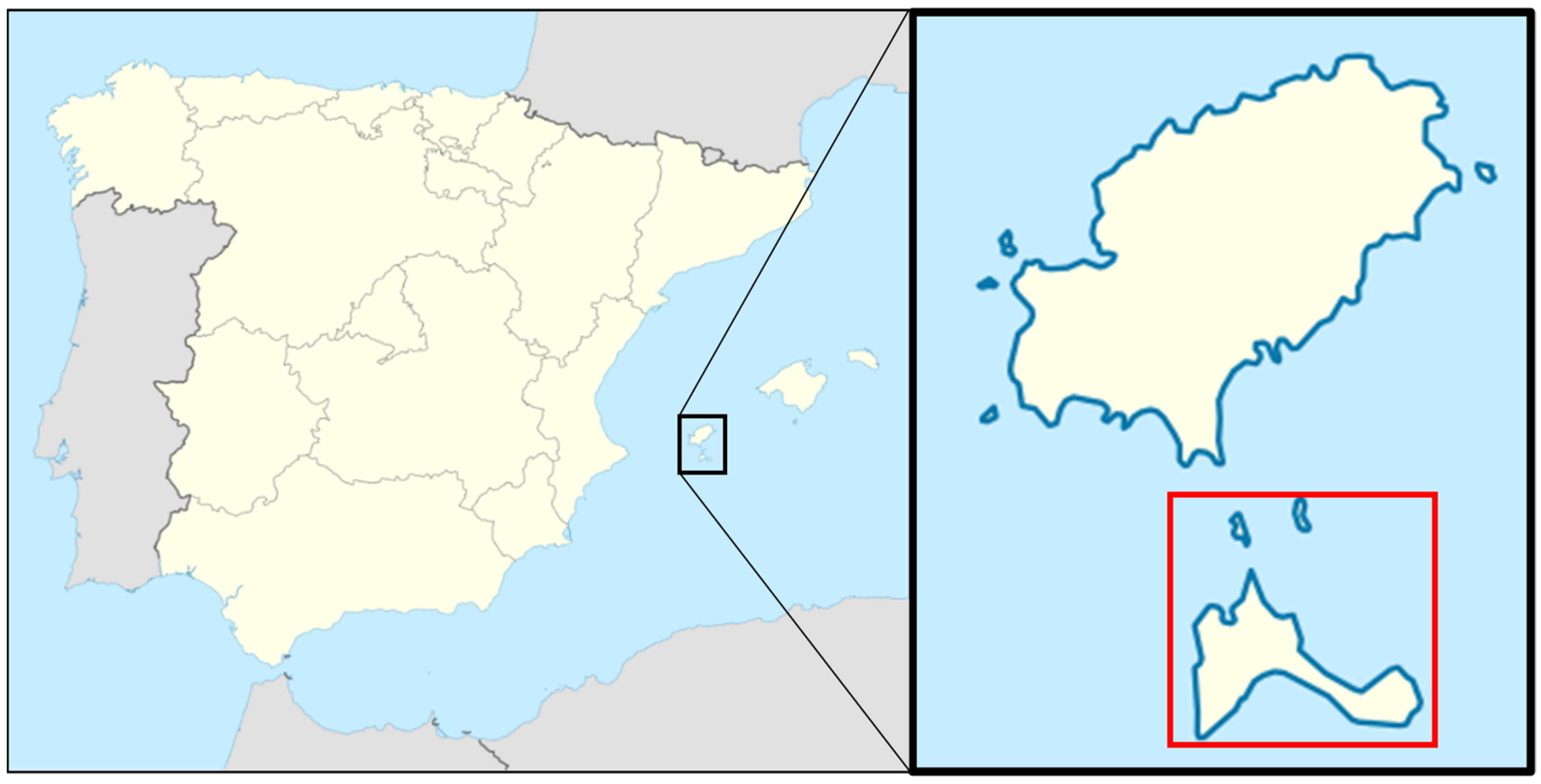
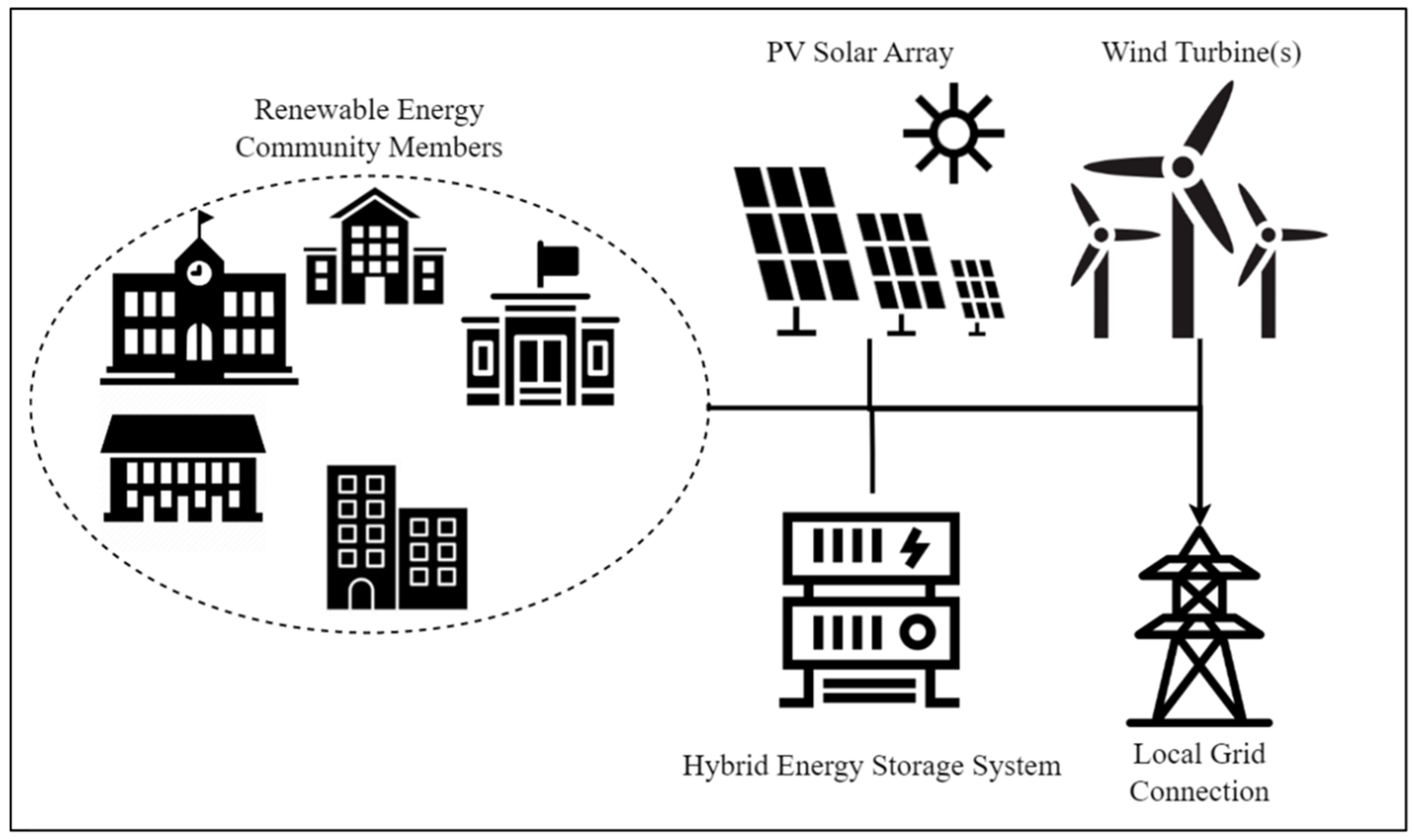

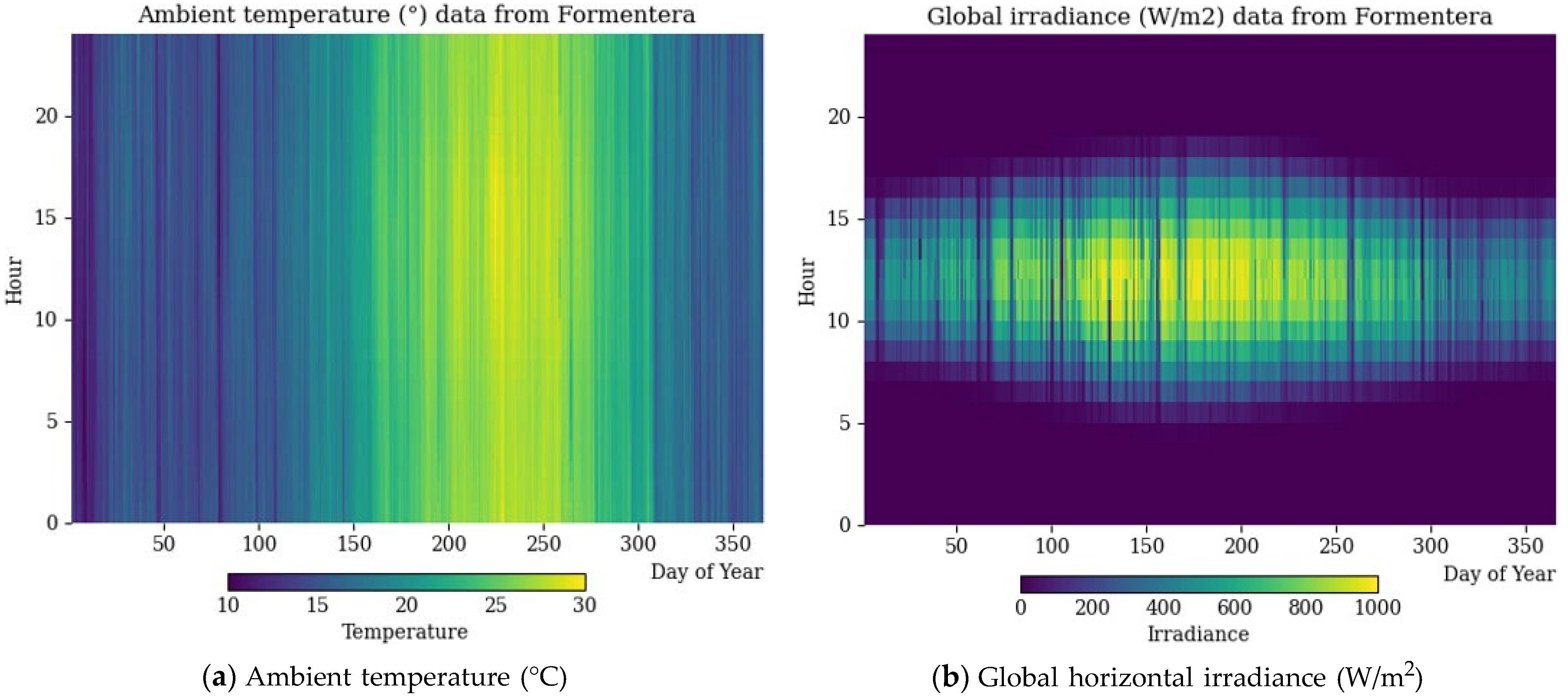
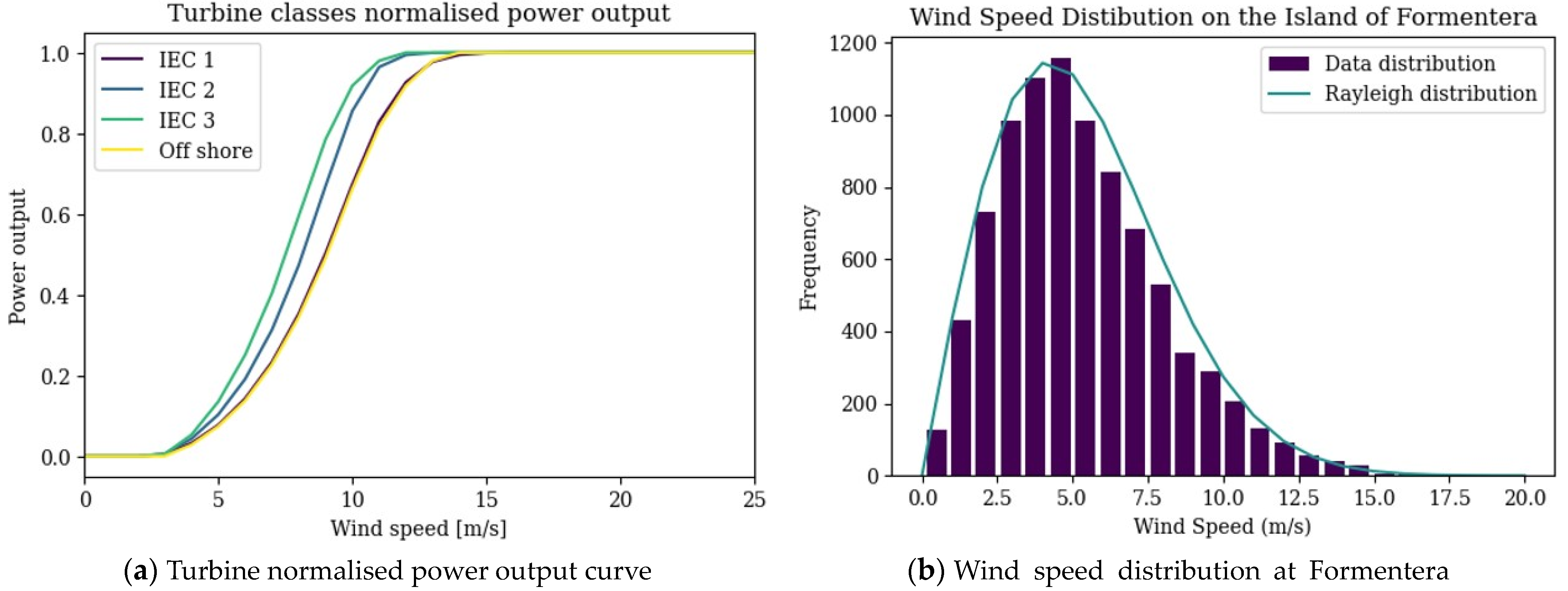

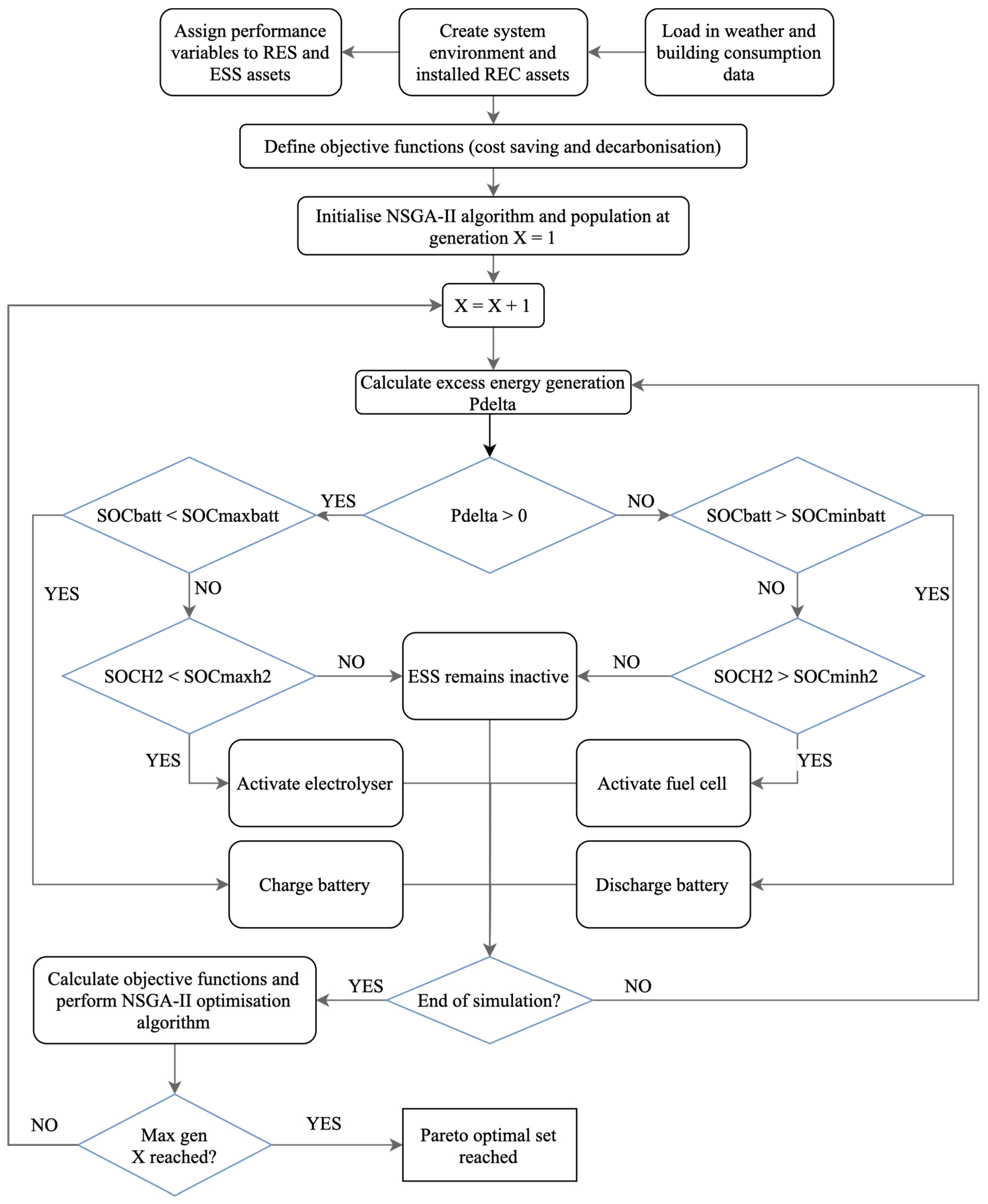
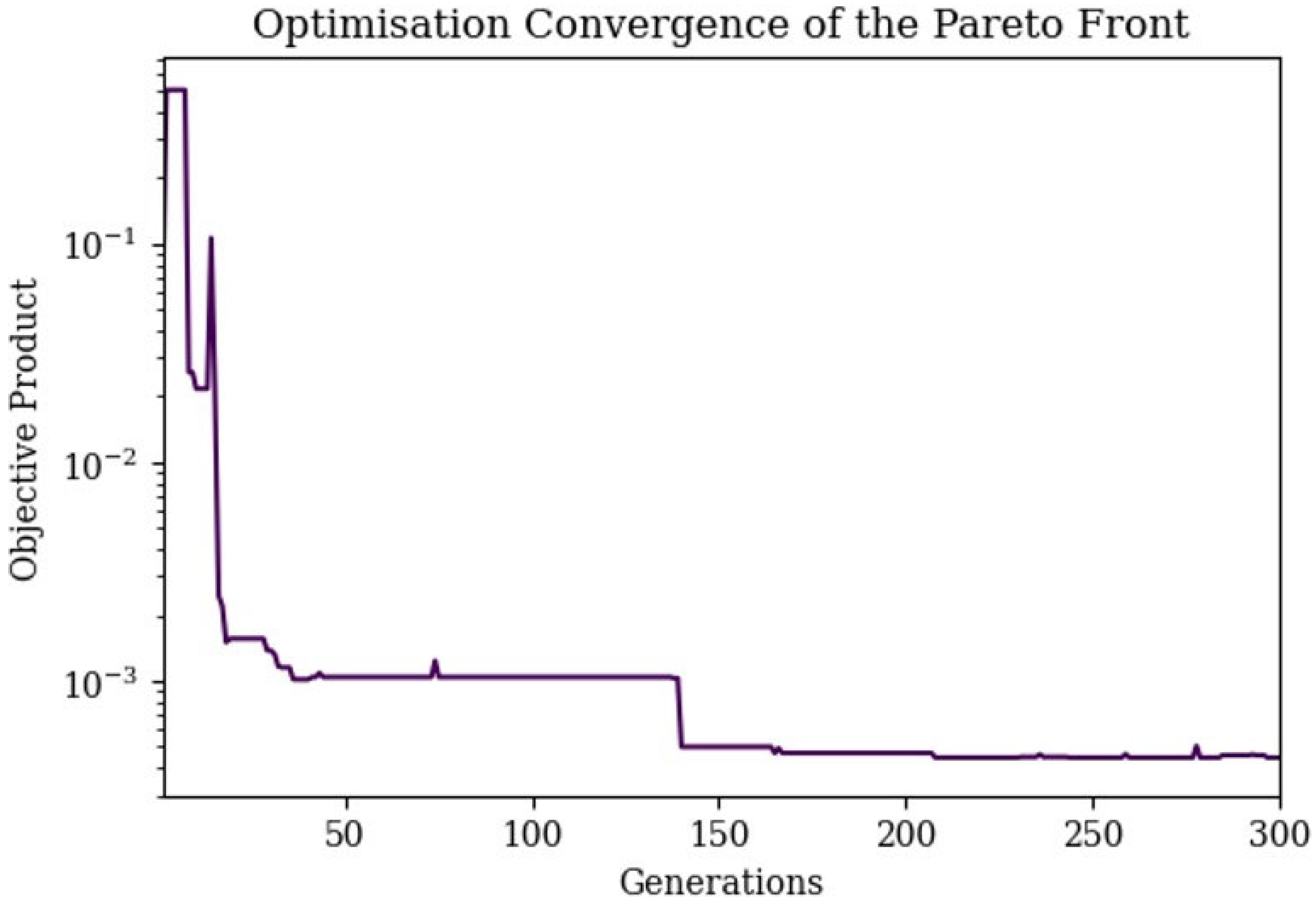
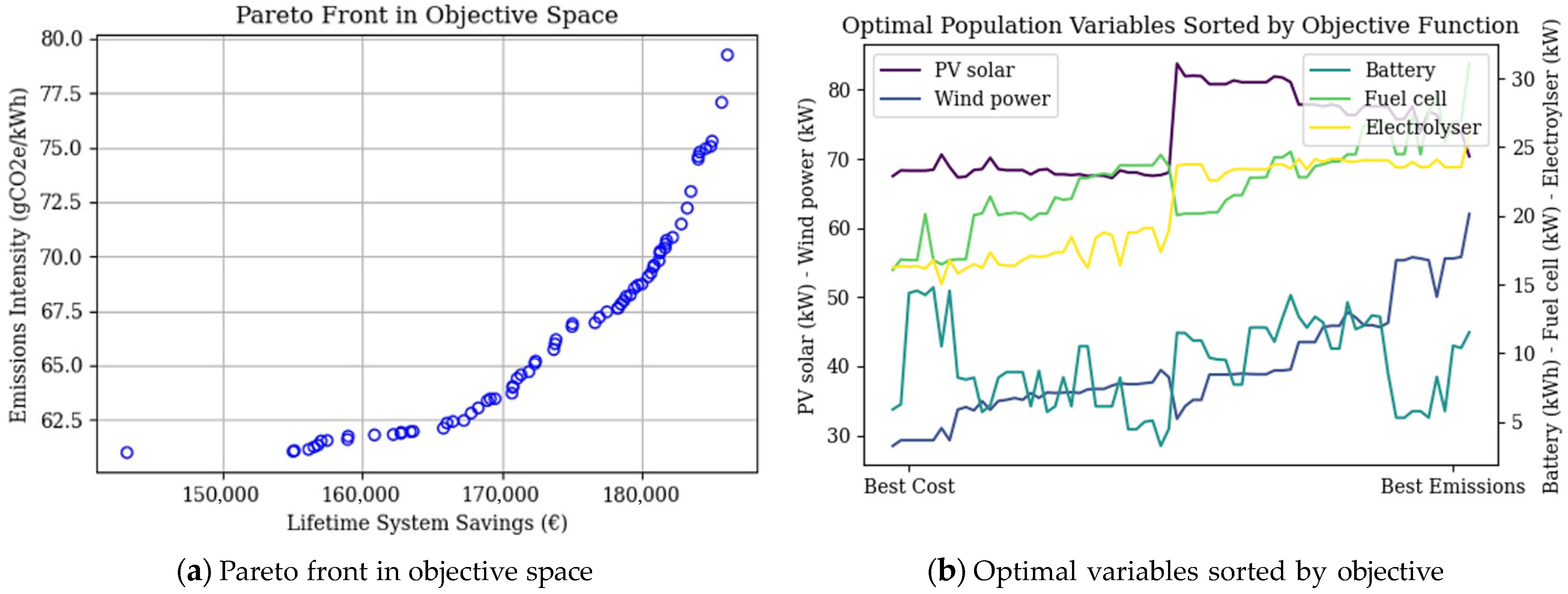
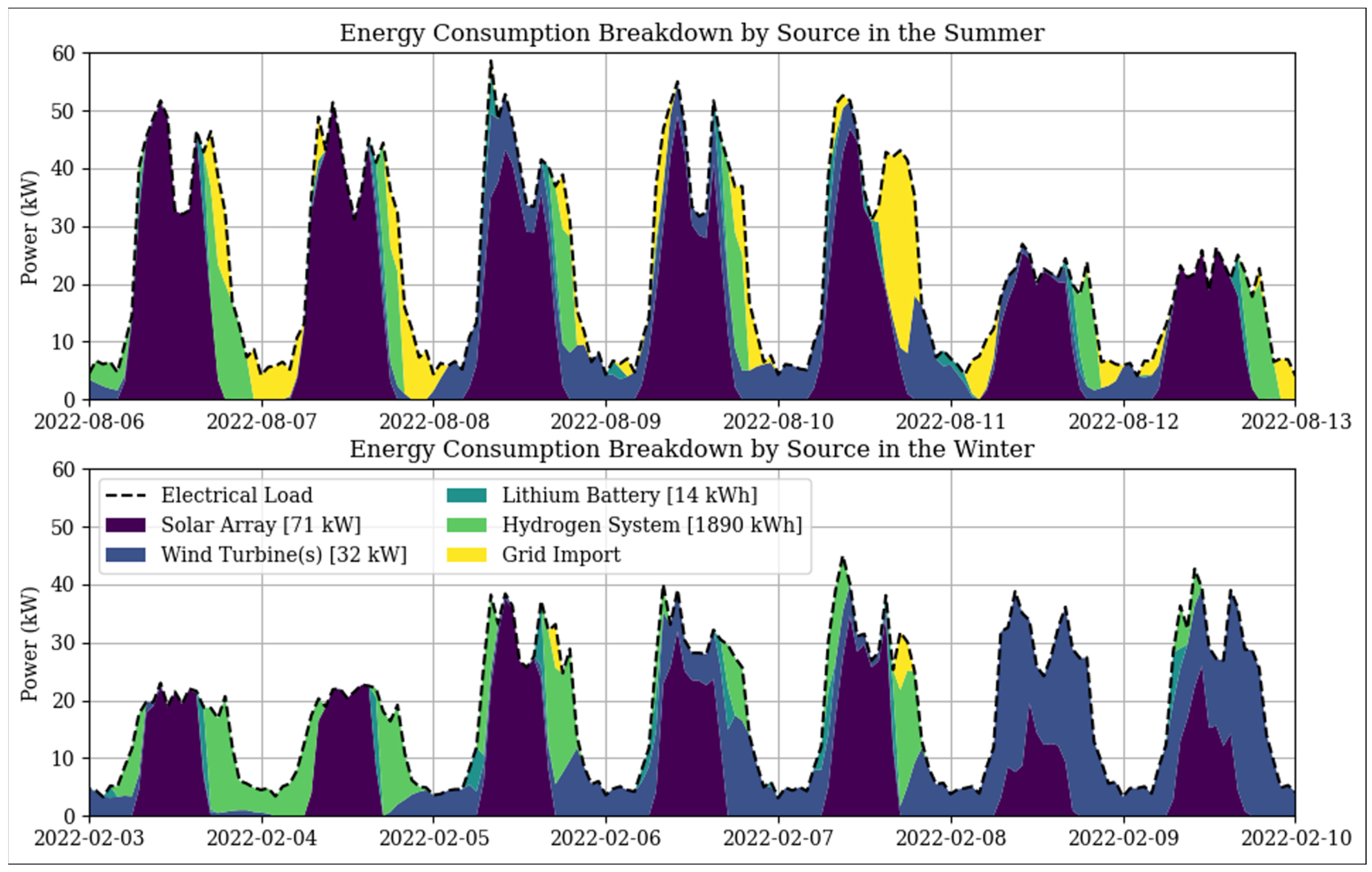
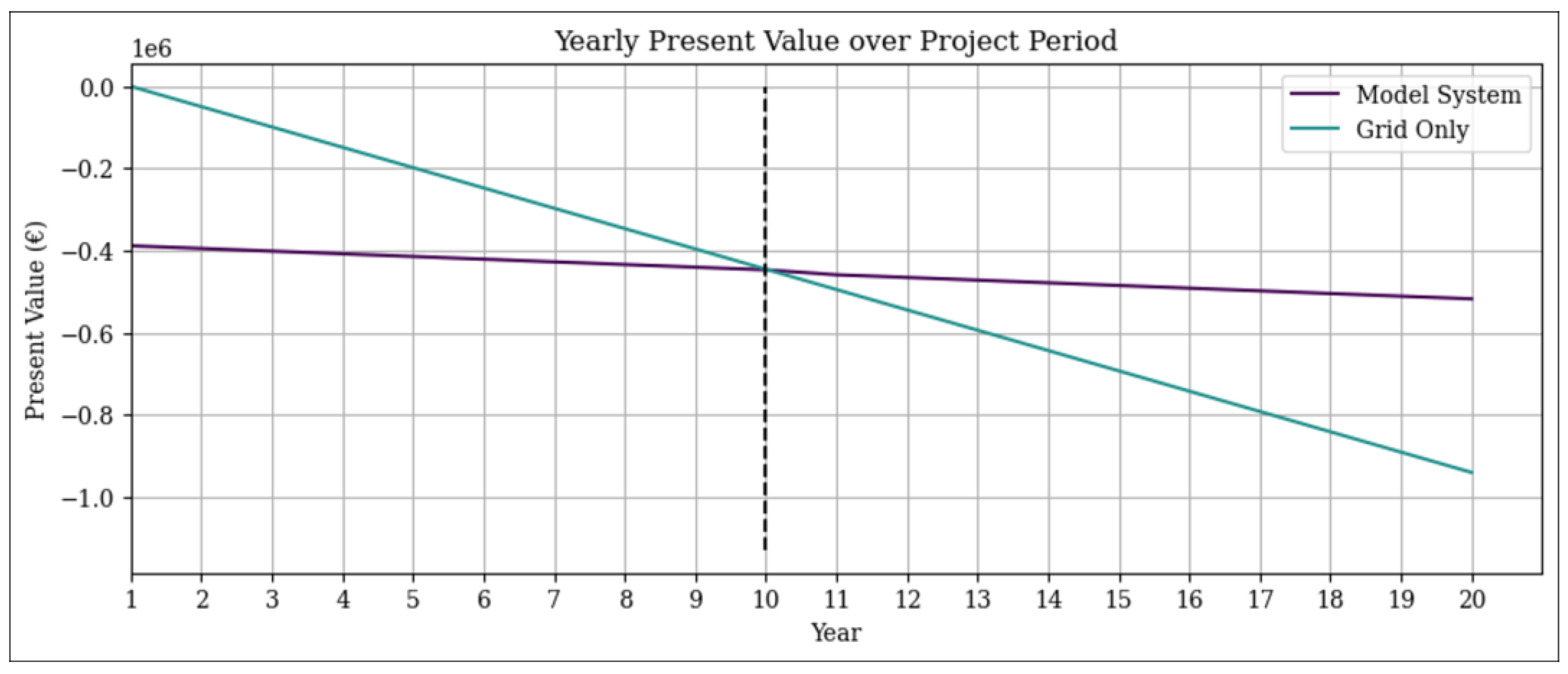

| Annual Consumption | |
|---|---|
| Community centre | 66,500 |
| Elementary school | 19,200 |
| High school | 46,200 |
| Government offices | 28,900 |
| 3× Residential units | 12,000 |
| PV Solar | |
|---|---|
| Panel Power (W) | 400 |
| Panel Area (m2) | 2 |
| Thermal Coefficient (%/°C) | −0.3 |
| NOCT (°C) | 42 |
| Lifetime (years) | 20 |
| Wind turbine | |
| Hub Height (m) | 20 |
| Roughness Height (m) | 0.05 |
| Lifetime (years) | 20 |
| Lithium battery | |
| Total Efficiency (%) | 95 |
| Maximum Cycles | 8000 |
| Maximum Age (years) | 10 |
| Regenerative hydrogen fuel cell | |
| Fuel Cell Efficiency (%) | 46 |
| Electrolyser Efficiency (%) | 68 |
| Lifetime (years) | 20 |
| Technology | CAPEX | OPEX | Lifetime | Emissions |
|---|---|---|---|---|
| Embedded | ||||
| PV Solar Array [55,56,57] | 2500 EUR/kW | 30 EUR/kW/year | 20 years | 1826 kgCO2e/kW |
| Wind Turbine [58,59] | 2850 EUR/kW | 32 EUR/kW/year | 20 years | 520 kgCO2e/kW |
| Lithium-Ion LFP [18,60] | 328 EUR/kWh | 5 EUR/kWh/year | 10 years or 8000 cycles | 254 kgCO2e/kWh |
| PEM Fuel Cell [18,61] | 1200 EUR/kW | 13 EUR/kW/year | 20 years | 73.3 kgCO2e/kWh |
| AEM Electrolyser [18,62,63] | 1500 EUR/kW | 14 EUR/kW/year | 20 years or 35,000 h | 239 kgCO2e/kWh |
| Hydrogen Storage Vessel [64,65,66] | 30 EUR/kWh | - | 20+ years | 5.1 kgCO2e/kWh |
| Parameter | Value |
|---|---|
| Population Size | 72 |
| No. of Offspring | 24 |
| Max No. of Generations | 400 |
| Lower Bounds (all assets) | 0 kW/kWh |
| Upper Bounds (all assets) | 200 kW/kWh |
| REC Asset | Optimal Values |
|---|---|
| PV Solar | 71 kW |
| Wind Turbine(s) | 32 kW |
| Lithium Battery | 14 kWh |
| PEM Fuel Cell | 20 kW |
| AEM Electrolyser | 18 kW |
| Technology Asset | Energy-Delivered (kWh) | Capacity-Factor (%) | CAPEX (EUR) | OPEX (EUR/year) | LCOE (EUR/kWh) | Emissions (gCO2e/kWh) |
|---|---|---|---|---|---|---|
| PV Solar [71 kW] | 141,184 | 19 | 177,500 | 2130 | 0.07 | 40.7 |
| Wind Turbine(s) [32 kW] | 60,517 | 22 | 91,200 | 1024 | 0.09 | 15.9 |
| Lithium Battery [14 kWh] | 4910 | 8 | 5446 | 308 | 0.08 | 72.4 |
| Hydrogen System [1836 kWh] | 26,360 | 15 | 106,000 | 570 | 0.17 | 18.6 |
| REC Member | REC Delivered (kWh) | Grid Delivered (kWh) |
|---|---|---|
| Community centre | 61,078 | 5461 |
| Elementary school | 18,807 | 348 |
| High school | 44,743 | 1437 |
| Council offices | 28,244 | 683 |
| Residential units | 11,975 | 514 |
| Best Net Savings | Nominal | Best Emissions Savings | |
|---|---|---|---|
| REC Delivered (kWh) | 151,493 | 156,536 | 158,823 |
| Self-Consumption (%) | 91.0 | 94.5 | 96.2 |
| LCOE (EUR/kWh) | 0.15 | 0.16 | 0.19 |
| Net Savings (EUR) | 187,080 | 178,229 | 139,647 |
| Savings (%) | 51 | 47 | 36 |
| IRR (%) | 12.6 | 10.9 | 7.1 |
| Simple Payback (%) | 10.1 | 9.6 | 8.0 |
| Payback Term (years) | 8.3 | 9.0 | 11.5 |
| Emissions | 79 | 69 | 61 |
| (gCO2e/kwh) | |||
| Decarbonisation (%) | 75.6 | 78.8 | 81.2 |
| Reference | Smart Grid Architecture | Assets | Location | Scale | LCOE (EUR/kWh) |
|---|---|---|---|---|---|
| This work | Energy community | Solar, wind, battery/RHFC | Formentera, Spain | <100 kW | 0.15 |
| [55] | DC microgrid | Solar, battery/RHFC | Sub-Saharan | <100 kW | 0.16 |
| [72] | AC microgrid | Solar/wind, genset/RHFC | Morocco | <1 MW | 0.07 |
| [73] | AC microgrid | Solar/wind, hydrogen | India | <1 MW | 0.08 |
| [74] | Energy community | Solar/wind, battery/RHFC | Ghana | <100 kW | 0.26 |
| [75] | Energy community | Solar/wind, hydrogen | Canada | >1 MW | 0.08 |
Disclaimer/Publisher’s Note: The statements, opinions and data contained in all publications are solely those of the individual author(s) and contributor(s) and not of MDPI and/or the editor(s). MDPI and/or the editor(s) disclaim responsibility for any injury to people or property resulting from any ideas, methods, instructions or products referred to in the content. |
© 2023 by the authors. Licensee MDPI, Basel, Switzerland. This article is an open access article distributed under the terms and conditions of the Creative Commons Attribution (CC BY) license (https://creativecommons.org/licenses/by/4.0/).
Share and Cite
Garner, R.; Dehouche, Z. Optimal Design and Analysis of a Hybrid Hydrogen Energy Storage System for an Island-Based Renewable Energy Community. Energies 2023, 16, 7363. https://doi.org/10.3390/en16217363
Garner R, Dehouche Z. Optimal Design and Analysis of a Hybrid Hydrogen Energy Storage System for an Island-Based Renewable Energy Community. Energies. 2023; 16(21):7363. https://doi.org/10.3390/en16217363
Chicago/Turabian StyleGarner, Robert, and Zahir Dehouche. 2023. "Optimal Design and Analysis of a Hybrid Hydrogen Energy Storage System for an Island-Based Renewable Energy Community" Energies 16, no. 21: 7363. https://doi.org/10.3390/en16217363
APA StyleGarner, R., & Dehouche, Z. (2023). Optimal Design and Analysis of a Hybrid Hydrogen Energy Storage System for an Island-Based Renewable Energy Community. Energies, 16(21), 7363. https://doi.org/10.3390/en16217363








